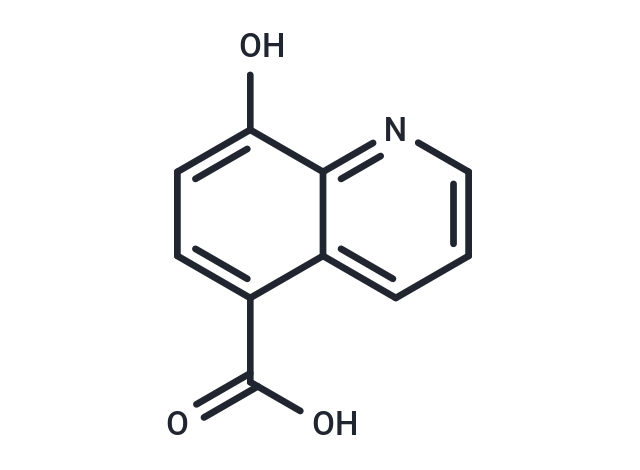Shopping Cart
- Remove All
 Your shopping cart is currently empty
Your shopping cart is currently empty

IOX1 is the most effective broad-spectrum 2OG oxygenases(including the JmjC demethylases) inhibitor. The IC50 of IOX1 for KDM4A, KDM3A, is 0.6 and 0.1 uM, respectively.

| Pack Size | Price | Availability | Quantity |
|---|---|---|---|
| 2 mg | $38 | In Stock | |
| 5 mg | $61 | In Stock | |
| 10 mg | $90 | In Stock | |
| 25 mg | $198 | In Stock | |
| 50 mg | $328 | In Stock | |
| 100 mg | $487 | In Stock | |
| 1 mL x 10 mM (in DMSO) | $67 | In Stock |
| Description | IOX1 is the most effective broad-spectrum 2OG oxygenases(including the JmjC demethylases) inhibitor. The IC50 of IOX1 for KDM4A, KDM3A, is 0.6 and 0.1 uM, respectively. |
| Targets&IC50 | KDM3A:0.1 uM, KDM4A:0.6 uM |
| In vitro | IOX1with an in vitro IC50 value in the micromolar range is the most effective against a representative panel of 2OG oxygenases, including non-JmjC 2OG oxygenases. In HeLa cells, however, its IC50 is 86uM, which efficacy is about a hundred-fold lower, possibly because of low cell permeability resulting from its polar C-5 carboxyl group. |
| Kinase Assay | AlphaScreen Assay: All reagents are diluted in 50 mM HEPES, 0.1% BSA, pH 7.5 supplemented with 0.01% Tween20 and allowed to equilibrate to room temperature prior to addition to plates. Catalytic turnover assays are run in 10 μL volumes in lowvolume 384-well plates at RT. The reaction consisted of enzyme (5 nM), biotinylated substrate peptide (30 nM), Fe(II) (1 μM), ascorbate (100 μM), 2OG (10 μM) and run at RT. For PHD2, the reaction consisted of enzyme (5 nM), biotinylated substrate peptide (60 nM), Fe(II) (20 μM), ascorbate (200 μM), 2OG (2 μM) and run at RT. EDTA is used to quench the reaction (5 μL), AlphaScreen donor (Streptavidin-conjugated) and acceptor (Protein A-conjugated) beads preincubated with peptide product antibodies are added (5 μL). Plates are foil-sealed to protect from light, incubated at room temperature for 60 minutes and read on a PHERAstar FS plate reader using an AlphaScreen 680 excitation/570 emission filter set. The final bead concentration in 20 μL reaction is 20 μg/mL. IC50 values are calculated in Prism 6 after normalisation against corresponding DMSO controls. |
| Cell Research | Antiproliferative activities of compounds are determined by the MTT assay. HeLa cells are seeded into 96-well plates and cultured at 37 °C for 24 h to achieve 70%. Subsequently, the medium is replaced with DMEM medium containing the tested compounds in different concentrations of 1-300 μM in 1% DMSO. Staurosporine in 0.03-10 μM final concentration is used as a control for cytotoxicity. After 24 h of treatment, the medium is replaced with CellTiter 96 Aqueous One Solution Reagent and incubated for 4 hours. CC50 values are calculated in Prism 6 software after normalisation against corresponding 1% DMSO treated cells and 1% DMSO in media (no cells) controls.(Only for Reference) |
| Molecular Weight | 189.17 |
| Formula | C10H7NO3 |
| Cas No. | 5852-78-8 |
| Smiles | OC(=O)c1ccc(O)c2ncccc12 |
| Relative Density. | 1.480 g/cm3 (Predicted) |
| Storage | Powder: -20°C for 3 years | In solvent: -80°C for 1 year | Shipping with blue ice. | |||||||||||||||||||||||||||||||||||
| Solubility Information | DMSO: 50 mg/mL (264.31 mM), Sonication is recommended. | |||||||||||||||||||||||||||||||||||
Solution Preparation Table | ||||||||||||||||||||||||||||||||||||
DMSO
| ||||||||||||||||||||||||||||||||||||

Copyright © 2015-2025 TargetMol Chemicals Inc. All Rights Reserved.